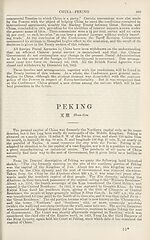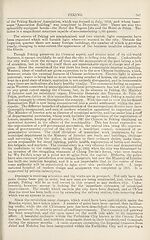1924
(652) Page 586
Download files
Complete book:
Individual page:
Thumbnail gallery: Grid view | List view

586
PEKING
The present city of Peking is divided into two portions, the Northern or Tartar
city and the Southern or Chinese. The former has been encroached upon by
the Chinese, and the purely Manchu section of the capital is very limited indeed.
The southern city is exclusively occupied by Chinese. The general shape of
Peking may be roughly represented by a square placed upon an oblong, the former
standing for the Tartar and the latter for the Chinese city. The 'whole of the capital
is, of course, walled. The wall s of the Tartar city are the strongest. They average 50 feet
in height and 40 feet in width, and are buttressed at intervals of about sixty yards.
The parapets are loop-holed and crenelated. They are faced on both sides with brick,
the space between being filled with earth and concrete. Each of the gateways is
surmounted by a three-storied pagoda. The walls of the Chinese city are about 30 feet
in height, 25 feet thick at the base, and 15 feet wide on the terre plein. The total
circumference of the walls round the two cities slightly exceeds 20 miles.
The Tartar city consists of three enclosures, one within the other, each
surrounded by its own wall. The innermost, called Kin-ching or Forbidden
City, contains the Imperial Palace and its surrounding buildings (partly destroyed by
fire in 1923); the second is occupied by the several offices appertaining to the
Government and by private residences of officials; while the outer consists of dwelling-
houses, with shods in the chief avenues.
There is little direct foreign trade with Peking, but it is growing and the
time cannot be far off when the city will be thrown open to trade. In August,
1884, the city was brought into direct telegraphic communication with the rest
of the world, by an overland line to Tientsin via Tungchow. The Ministry of
Communications has now its own wireless installation. The year 1899 witnessed
two other innovations, which would have been regarded as impossible ten
years previously, viz., the erection of large two-storied buildings on prominent sites for
the Austrian Legation and the Hongkong and Shanghai Bank. These were breaks with
immemorial tradition that the feng-shui must resent elevation in houses other than
those of the immortal gods and the Son of Heaven. The railway line to Tientsin was
opened in 1897. A further link between the two places was forged in 1922 by means
of a wireless telephone system, the plant for which was installed for the Chinese
Government by the China Electric Co.
Peking, though it suffered indescribably from the depredations of the Boxers*
the Imperial troops, the awful ruffianism of Tung-fuh-shiang’s barbarians from Kansu,
to say nothing of the subsequent attentions of the Allied troops, is at present more
attractive as an object of travel than before, for the simple reason that the city was
cleansed by the foreign Powers, and many places of antiquarian, artistic or
historic interest are now accessible if the visitor sets about his object with due
attention to national susceptibilities. Unfortunately, in Peking, as elsewhere in
China, the monuments of the past are neglected, except perhaps those in the Forbidden
City, and are fast crumbling into ruins.
During 1902 the fortification of the Legation quarter was completed, the railway
termini brought to the ChUen Men in the Chinese city, and the reconstruction of the
various Legations was begun. These were slowly brought to completion, and extensive
barracks connected with each for the accommodation of the Legation Guards. As
most Chinese buildings in this section were removed the Legation quarter presents the
appearance of a European settlement of about half a square mile in extent. There are
several large stores, which sell all kinds of foreign goods. The Peking Club is much
larger and more convenient than it was before; there is a Catholic Church for the
Legation Guards, and several hospitals—Rockefeller Foundation (a handsome and
splendidly equipped institution, the opening of which marked an epoch in the history
of Peking), Dojin (Japanese, completed in 1917), Central, German, St. Michael’s and the
Methodist Episcopal John L. Hopkins Memorial—which are provided with accommoda¬
tion for both Chinese and European patients. There are many foreign banks, the most
important of which are the Hongkong and Shanghai Banking Corporation, Russo-Asiatic
Bank, Banque de ITndo-Chine, Banque Industrielle de Chine, Banque Beige Pour
I’Etranger, International Banking Corporation, Asia Banking Corporation, Sino-Italian
Bank, Chartered Bank of India, Australia and China, and Yokohama Specie Bank. There
are also numerous Chinese banks—headed by the official Bank of China and Bank of
Communications—the progress of which on modern lines is one of the signs of the
times. Banking enterprises of both Chinese and Sino-Chinese capitalisation are
springing up with mushroom-like rapidity. Most of the native banks are members
PEKING
The present city of Peking is divided into two portions, the Northern or Tartar
city and the Southern or Chinese. The former has been encroached upon by
the Chinese, and the purely Manchu section of the capital is very limited indeed.
The southern city is exclusively occupied by Chinese. The general shape of
Peking may be roughly represented by a square placed upon an oblong, the former
standing for the Tartar and the latter for the Chinese city. The 'whole of the capital
is, of course, walled. The wall s of the Tartar city are the strongest. They average 50 feet
in height and 40 feet in width, and are buttressed at intervals of about sixty yards.
The parapets are loop-holed and crenelated. They are faced on both sides with brick,
the space between being filled with earth and concrete. Each of the gateways is
surmounted by a three-storied pagoda. The walls of the Chinese city are about 30 feet
in height, 25 feet thick at the base, and 15 feet wide on the terre plein. The total
circumference of the walls round the two cities slightly exceeds 20 miles.
The Tartar city consists of three enclosures, one within the other, each
surrounded by its own wall. The innermost, called Kin-ching or Forbidden
City, contains the Imperial Palace and its surrounding buildings (partly destroyed by
fire in 1923); the second is occupied by the several offices appertaining to the
Government and by private residences of officials; while the outer consists of dwelling-
houses, with shods in the chief avenues.
There is little direct foreign trade with Peking, but it is growing and the
time cannot be far off when the city will be thrown open to trade. In August,
1884, the city was brought into direct telegraphic communication with the rest
of the world, by an overland line to Tientsin via Tungchow. The Ministry of
Communications has now its own wireless installation. The year 1899 witnessed
two other innovations, which would have been regarded as impossible ten
years previously, viz., the erection of large two-storied buildings on prominent sites for
the Austrian Legation and the Hongkong and Shanghai Bank. These were breaks with
immemorial tradition that the feng-shui must resent elevation in houses other than
those of the immortal gods and the Son of Heaven. The railway line to Tientsin was
opened in 1897. A further link between the two places was forged in 1922 by means
of a wireless telephone system, the plant for which was installed for the Chinese
Government by the China Electric Co.
Peking, though it suffered indescribably from the depredations of the Boxers*
the Imperial troops, the awful ruffianism of Tung-fuh-shiang’s barbarians from Kansu,
to say nothing of the subsequent attentions of the Allied troops, is at present more
attractive as an object of travel than before, for the simple reason that the city was
cleansed by the foreign Powers, and many places of antiquarian, artistic or
historic interest are now accessible if the visitor sets about his object with due
attention to national susceptibilities. Unfortunately, in Peking, as elsewhere in
China, the monuments of the past are neglected, except perhaps those in the Forbidden
City, and are fast crumbling into ruins.
During 1902 the fortification of the Legation quarter was completed, the railway
termini brought to the ChUen Men in the Chinese city, and the reconstruction of the
various Legations was begun. These were slowly brought to completion, and extensive
barracks connected with each for the accommodation of the Legation Guards. As
most Chinese buildings in this section were removed the Legation quarter presents the
appearance of a European settlement of about half a square mile in extent. There are
several large stores, which sell all kinds of foreign goods. The Peking Club is much
larger and more convenient than it was before; there is a Catholic Church for the
Legation Guards, and several hospitals—Rockefeller Foundation (a handsome and
splendidly equipped institution, the opening of which marked an epoch in the history
of Peking), Dojin (Japanese, completed in 1917), Central, German, St. Michael’s and the
Methodist Episcopal John L. Hopkins Memorial—which are provided with accommoda¬
tion for both Chinese and European patients. There are many foreign banks, the most
important of which are the Hongkong and Shanghai Banking Corporation, Russo-Asiatic
Bank, Banque de ITndo-Chine, Banque Industrielle de Chine, Banque Beige Pour
I’Etranger, International Banking Corporation, Asia Banking Corporation, Sino-Italian
Bank, Chartered Bank of India, Australia and China, and Yokohama Specie Bank. There
are also numerous Chinese banks—headed by the official Bank of China and Bank of
Communications—the progress of which on modern lines is one of the signs of the
times. Banking enterprises of both Chinese and Sino-Chinese capitalisation are
springing up with mushroom-like rapidity. Most of the native banks are members
Set display mode to:
![]() Universal Viewer |
Universal Viewer | ![]() Mirador |
Large image | Transcription
Mirador |
Large image | Transcription
Images and transcriptions on this page, including medium image downloads, may be used under the Creative Commons Attribution 4.0 International Licence unless otherwise stated. ![]()
| Asian directories and chronicles > 1924 > (652) Page 586 |
|---|
| Permanent URL | https://digital.nls.uk/196432359 |
|---|
| Attribution and copyright: |
|
|---|---|
| Description | Volumes from the Asian 'Directory and Chronicle' series covering 1917-1941, but missing 1919 and 1923. Compiled annually from a multiplicity of local sources and research. They provide listings of each country's active corporations, foreign residents and government agencies of all nationalities for that year, together with their addresses. Content includes: various treaties; coverage of conflicts; currencies and taxes; consular fees; weights and measures; public holidays; festivals and traditions. A source of information for both Western states and communities of foreigners living in Asia. Published by Hongkong Daily Press. |
|---|---|
| Shelfmark | H3.86.1303 |
| Additional NLS resources: |

